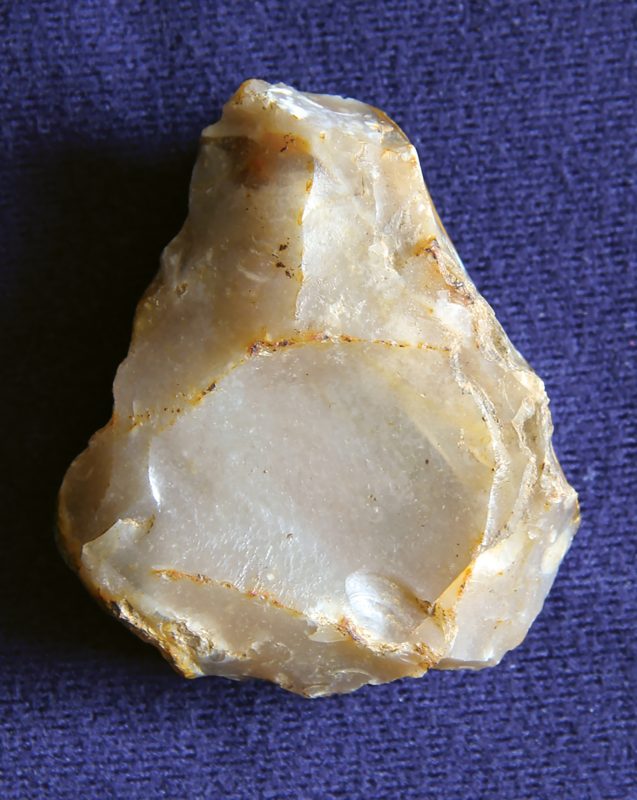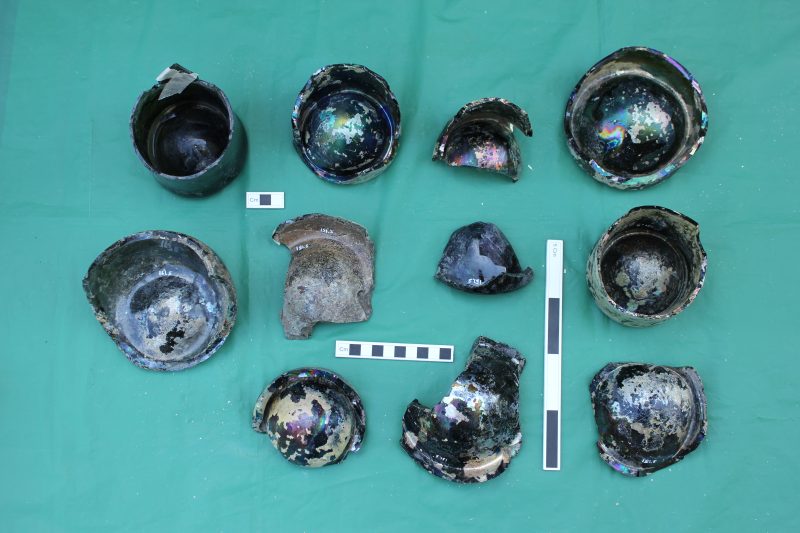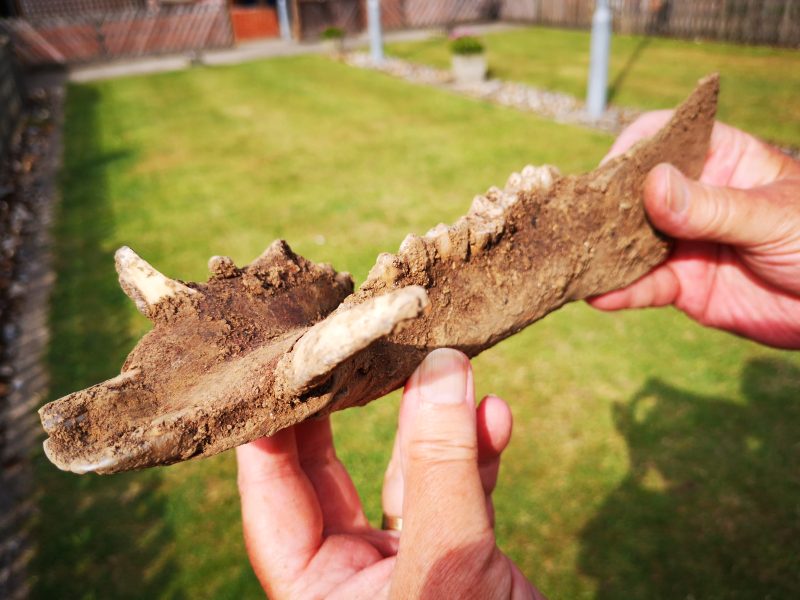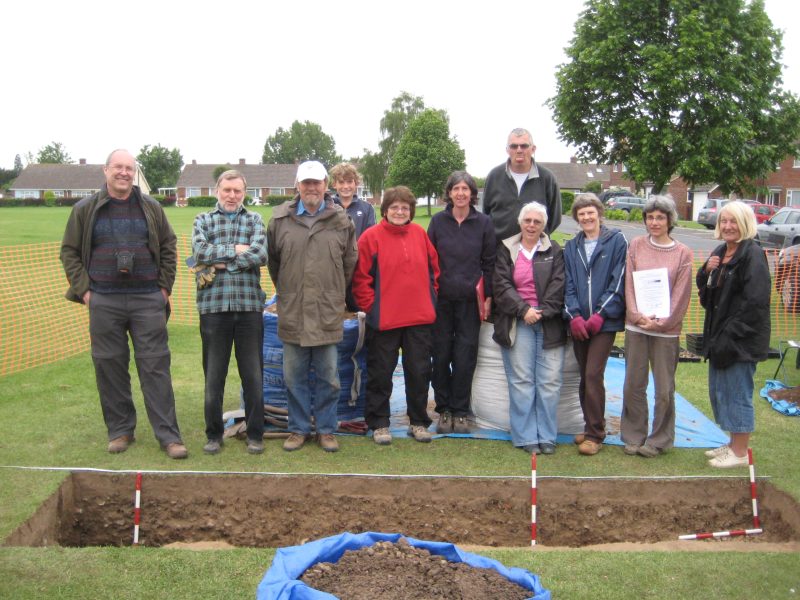Words Justin Croft Photographs Pat Reid/FSARG and Justin Croft
Hidden Faversham was introduced by its author, Patricia Reid, with a lively conversation which filled the Guildhall with an enthusiastic and enthralled audience. We were lucky to have secured a ticket, but arrived a moment late to find Pat already well into her stride explaining why Faversham is so special for archaeologists. Quite simply, the town is set in one of the earliest settled areas of Britain, inhabited by early man (and women) soon after the last Ice Age as the ice retreated some 20,000 years ago. With the remains of such an immense period of human habitation lying under our feet, it is no surprise that archaeologists should have Faversham in their sights.

The new book. Hot off the press.
Listening to Pat and looking at Hidden Faversham (which we duly bought and had inscribed by the author) even this huge timeframe is a mere whisker, given the flint hand-axe found in Ospringe by the Faversham Society Archaeological Research Group (FSARG, the volunteer group headed by Pat until recently). This beautiful and compelling stone artefact has been dated by experts at the British Museum as between 200,000 and 300,000 years old, suggesting that the area had even older Neanderthal inhabitants, living after a much earlier Ice Age.

The Ospringe hand-axe
It’s a dizzying prospect and it means that those of us interested in ‘history’ (periods of the past covered by written records) are pottering about in less than one percent of the vast chronological swathes of the human story. Thankfully we have Dr Reid to guide us through them and we can’t recommend her book highly enough.
It’s set out like an archaeological dig. Most books about the past start at the beginning and move forwards through time, but this one starts in 2024 and works backwards, briskly uncovering layer after layer of the town’s history. In around ninety pages it ends somewhere close to 400,000 years ago with the Ospringe hand-axe. Of course, it’s selective, concentrating on a series of digs carried out by FSARG, but Pat does a remarkable job of putting things in context, so that we always know where we are. Talking to her this week, we were not surprised to hear that she has been a teacher (of geography) for most of her career, developing an obvious gift for presenting complex information clearly but with obvious passion. She tells us that her interest in archaeology was first stimulated while studying for a degree in Anthropology at the London School of Economics, and that she returned to it after early-retirement, completing a Masters degree and Doctorate at the University of London before taking up the role of Community Archaeologist in Faversham in 2004.

Fragments of hand blown glass bottles
Her many carefully focused Faversham digs are meticulously recorded on the FSARG website but Pat described several highlights from her book in her talk. One of our favourites was her account of the 2017 dig in the garden behind number 6 Preston Street (Furlongs micropub). Here the team found masses of shattered pottery, fine china and hand-blown glass bottles under a metre of topsoil apparently deliberately dumped. Among the mainly 18th century fragments was a lot of typical British redware pottery, but also costly ceramics such as hand-painted Chinese porcelain and elegant Wedgwood creamware ― most apparently pristine and unused despite being in pieces.

Fine Chinese porcelain from the Preston Street site
The hoard posed an enigma, answered (dramatically) by patient and careful work in the archives. Part of the premises had been a rather high-class glass and china shop run by a Sarah Collier between 1757 and 1781 but by 1785 it had become a linen draper’s. It seemed highly unlikely that Sarah’s stock would simply be dumped, given its quality, so there had to be some other explanation for this back-garden crockery hoard. More documentary research reminded the team that 1781 witnessed one of the several gunpowder explosions well-known to Faversham historians. This explosion, while not as deadly as some later were, caused widespread damage across the town and it seems likely that Sarah Collier’s shop was affected and the stock destroyed, a hypothesis confirmed by a government compensation grant made to her five years later (of £5, roughly £2000 today). The dig provided a brilliant piece of evidence for Faversham’s past, but one only unravelled through the combined expertise of Pat’s expert volunteer team.

Part of a wild boar’s jaw bone from the Market Inn excavation
Taking us further back in time is the perhaps surprising evidence from the pub garden of the Market Inn (East Street, adjoining the Rec). Here the FSARG team uncovered an Anglo-Saxon rubbish dump. That may seem uninspiring compared with the astounding Saxon jewellery found long ago at the nearby Kingsfield burial site, but to an archaeologist it was better than gold-dust. In the footings of a disused Saxon structure, the dump contained huge numbers of animal bones, including deer and wild boar, providing evidence of serious feasting, not just everyday subsistence. To Pat, who has an obvious affection for this period and who refers to this kind of find as ‘feasting bone’, it denotes a very high-status dwelling or complex in this area of the town, perhaps even pointing towards the long-suspected but never found Saxon King’s Manor here in Faversham.

A FSARG group at work, Pat Reid on the right
There is so much more to uncover in Hidden Faversham than these two highlights. There is also still a great deal of archaeology to be done in Faversham and the town is fortunate to have the FSARG team steered by Pat Reid over its first 20 years. She’s now passed over the trowel to her successors but remains heavily involved in the group’s work and publications. If you are interested to know more, or perhaps even to get involved, please look at the ‘How to discover Hidden Faversham’ at the back of the book or go to the group’s excellent website.
Hidden Faversham: an ancient Town unearthed by Patricia Reid (and edited by Stephen Rayner) is published by Faversham Society Publishing and is available from the Faversham Society via the visitor information centre at 12, Market Place, Faversham. If you missed the literary festival talk a meet-the-author event is planned for 24th March 2024 (Assembly Rooms, 2pm).